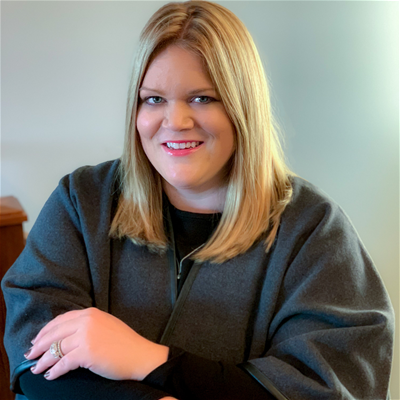 When Ashley Podhradsky became the first woman to earn her doctorate from Dakota State University in South Dakota in 2010, little did she know the impact she would have nationally on the lives of girls and women in the male-dominated field of cyber sciences. She spent five years at Drexel University in Philadelphia before returning to Dakota State.
When Ashley Podhradsky became the first woman to earn her doctorate from Dakota State University in South Dakota in 2010, little did she know the impact she would have nationally on the lives of girls and women in the male-dominated field of cyber sciences. She spent five years at Drexel University in Philadelphia before returning to Dakota State.
“What I noticed right away was that I was usually the only woman in the room—in both classes I took and classes I taught,” she recalls. “I thought about how it’s been a long time and things should be getting better.”
And when people would ask why there weren’t more women in the room, her colleagues would answer, “Oh, they’re just not interested in this area.” But she knew that wasn’t true.
The issue is more that “we’re not creating something for them.”
So create she did. Podhradsky co-founded the CybHER @ DSU program, which helps empower, motivate, educate and change the perception of girls and women in cybersecurity by providing programs geared toward middle school and up through college.
When CybHER’s camp launched in 2013, she guessed that about 70 girls would register—and 180 actually did. To date, CybHER’s initiatives have resulted in over 95 events and reached more than 14,000 girls, and the organization has raised over half a million dollars to fund its programs.
The impact is also felt directly at Dakota State. Its cyber-related academic programs—computer science, network security administration and cyber operations—went from 40 women participating in 2013 to over 160 women today; 40% of new students in the Beacom College of Computer and Cyber Sciences this past fall were women.
Podhradsky will be one of four presenters at the Women in Technology pre-conference on June 10 at UB Tech® 2019 in Orlando. Attendees of her session, “CybHER @ DSU: A 300%+ Increase in Women Enrolled in the Beacom College,” will walk away with ideas for making a difference in the lives of girls and women, whether it’s on an everyday basis or whether it’s by starting similar events and programs. She will share CybHER’s various initiatives and explain how they work individually and together.
Dispelling stereotypes
One purpose of CybHER is to dispel stereotypes about what it’s like for women in technology fields. Rather than being about a person sitting in the dark in a parent’s basement, cyber science is “a fun, social and engaging field,” she says.
The programs go beyond simply discussing gender diversity issues. They go for a higher impact by showing girls how to crack passwords, and how the word “password” can be cracked in fraction of a millisecond, while a stronger password could take three months or three years to crack, even with current computing tools. Only after this will there be some information on how to make a stronger password. Participants will also learn how easy it is to recover deleted social media posts, teaching them to pause and think before posting.
They’ll also spend time creating phishing emails. “Ninety percent of what we do is hands on,” says Podhradsky. “We want that aha! moment to come from the students. And it’s so exciting to see that on the faces of the girls as they’re doing it.”
Resources well spent
Offering all of the CybHER initiatives, of course, requires resources and time. Podhradsky and her co-founder Pam Rowland are both faculty members and administrators with plenty of responsibilities. Podhradsky is an associate dean and associate professor of information assurance and forensics; Rowland is an assistant professor, co-director of the Center for Excellence for Information Systems, and undergraduate research coordinator. For their CybHER initiatives requiring time off, it helps that they have a supportive president. “We need these girls to be able to go out and get hooked and learn more, and then come to the university, or any university. And now we’re starting to see those gains,” Podhradsky says.
She hopes the Women in Technology pre-conference attendees will recognize that they are role models and that there are things they can do to help. “What we’re doing isn’t revolutionary, but we have lots of examples and resources on our websites,” she says, adding that it’s important to keep in mind the long-term gain of putting in the time.
For eight women at Dakota State, that time has included the opportunity to travel, for free, to a national Women in Cybersecurity conference, thanks to a corporate sponsor. Six female Dakota State students have been awarded $3,000 scholarships, and two K-12 teachers have gotten awards for technology use in their classrooms.
“One of the biggest things I stress when we’re looking at impacting gender diversity in cybersecurity is that we can’t silo ourselves,” says Podhradsky.
 That includes from men. Her son and daughter have attended CybHER events, and her son has asked for confirmation that he’s a cyber girl, too. Yes, boys play a key role—both in supporting women and in filling those plentiful cyber sciences jobs that have a shortage of applicants. “We need allies,” she says. “We need people from both genders helping us as we go forward.”
That includes from men. Her son and daughter have attended CybHER events, and her son has asked for confirmation that he’s a cyber girl, too. Yes, boys play a key role—both in supporting women and in filling those plentiful cyber sciences jobs that have a shortage of applicants. “We need allies,” she says. “We need people from both genders helping us as we go forward.”
Register for UB Tech® 2019 to attend the Women in Technology pre-conference and more.





